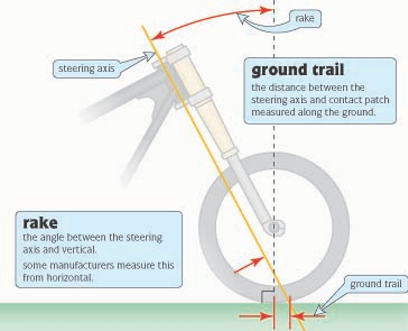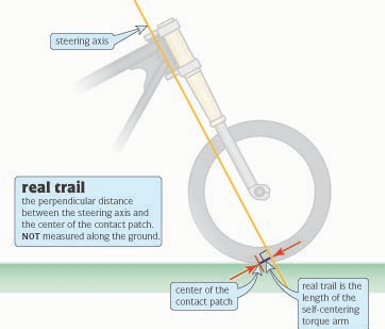Tale of the Trail
While talking to a friend the other day I mentioned that the CycleStats image of the bike’s geometry was not technically accurate when it came to the trail measurement, even though the numbers were correct.
“Well, why don’t you write a column about it then?” he retorted. Fair enough.
Ground Trail


Perhaps the most important geometry number for a modern motorcycle is front-end trail. What we commonly call “trail” is technically “ground trail.” It is the distance from the center of the tire contact patch to the steering axis, measured along the ground. In other words it is the amount the contact patch “trails” the steering axis and it is the basis for the numbers we post in MCN on the CycleStats pages.
Notice from the illustration that the steering axis is almost never the same as the middle of the fork as there is an offset in the triple clamps that has the fork legs forward of the actual steering axis. The axle may also be more forward than the fork legs, also known as axle offset, as shown in the illustrations.
More forward offset creates less trail. The more trail the more self-centering effect on the front wheel. This gives the bike more stability but it’s harder to turn the bars. Within a usable range more trail generally provides more grip (traction) when cornering. Most people have this concept backward; thinking more offset means a longer wheelbase and therefore more stability. While the wheelbase does grow with increased offset, the trail actually decreases and therefore stability decreases.
In order to calculate ground trail you need three things; rake (steering angle), wheel diameter (including tire), and total offset (triple clamp offset + axle offset). This is how the OEMs come up with the numbers.
Real Trail
We have been talking about ground trail. But there is a better way to measure trail—real trail. Trail is a measurement of the length of “lever arm” that provides the self-centering torque on the front wheel. Torque is a rotational force around an axis.
Torque = force x lever arm length (the perpendicular distance the force is applied away from the rotating axis). The key word here is perpendicular.
Ground trail is measured along the ground not perpendicular to the steering axis. Real trail is the distance from the steering axis to the center of the tire contact patch measured perpendicular to the steering axis. This is a much better method. That being said, ground trail can be valuable as a comparison method if wheel diameter and rake are held constant when making changes to your chassis, or comparing one model to another in our road tests.
This concept of real trail was first introduced by Tony Foale, a highly respected frame designer, author and engineer in his book “Motorcycle Chassis Design.” (www.tonyfoale.com).
While I certainly didn’t expect the steering axis to be perfectly measured and placed in our CycleStats images each month, I did want to set the record straight that there is more to the trail numbers than it might seem from the simplified pictures.


















